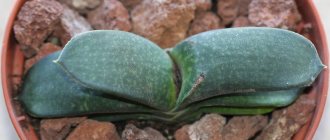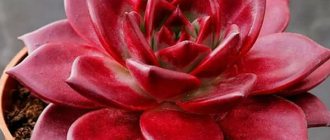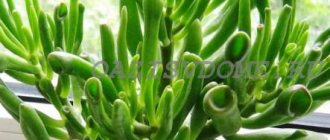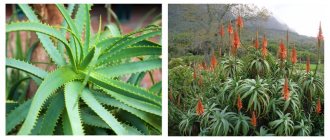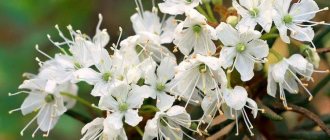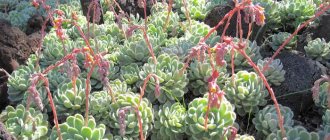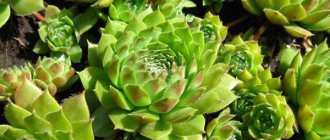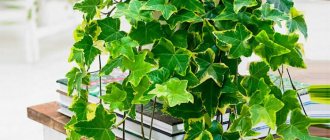Pachypodium belongs to the Kutrov family.
This crop can grow as a tree up to 8 m high.
It may look like an oval bush up to 4 m, and there are also dwarf species.
Of the large number of pachypodium species, about a dozen are planted in the house . These are varieties that represent the smallest plants with an unusual trunk shape.
Names, photos and distinctive features of flowers similar to cacti
An unusual plant with thorns instead of leaves can be found in almost every home. Many exotic plants are related to or closely resemble cacti, including the huge family of succulents.
It is sometimes difficult for an inexperienced gardener to distinguish a cactus from another flower. In this article we will tell you the names of plants that resemble cacti in their appearance.
Names and photos of plants resembling cacti
Agave
Agave is easy to identify by its appearance. Agave has large, fleshy, light green leaves, similar to aloe leaves with small spines along the edges. It blooms very rarely, the first time every 10-15 years. It can grow up to 12 meters.
Succulents store moisture in their leaves , but most cacti do not have them, so they store moisture in their stems. The most important distinguishing feature of cacti is the spines that grow from the areoles.
The agave plant is native to North America. Wild representatives of this exotic crop can be found in the desert, but there are also many indoor species of this plant. At home, agave has a variety of colors and low leaves no more than 60 cm long.
The unique culture does not require special care. It is enough to place your pet in a well-lit place, water it regularly and replant it once a year.
Read more about agave and prickly pear in this material.
Haworthia
Haworthia is a low herbaceous succulent plant. Native to South Africa, it has fleshy, tough leaves that are collected in a round rosette.
All types of haworthia have special, distinctive features:
- absence of a stem - foliage grows from a basal rosette;
- unsightly flowers of the same shape and short leaves no more than 5-10 cm in length.
Haworthia has an external resemblance to aloe and cactus. All these crops absorb moisture from the air.
In nature, Haworthia grows in arid areas - in the deserts and steppes of South Africa.
In countries with temperate climates, exotic crops can only be grown at home. Like all succulents, the plant is unpretentious. The southern heat-loving culture prefers shaded places instead of bright sun.
Heliocereus
Heliocereus is a bushy epiphytic plant native to Mexico. This is one of the most amazing representatives of the cactus family.
The hanging or erect stem in young plants is reddish-green , and in adults it is dark green. Heliocereus, like any other cactus, has spines - thin, long, yellow-brown.
Daytime heliocereus blooms during daylight hours. The long flowering period has made the plant decorative. After flowering, the plant is decorated with fruits - prickly, red, egg-shaped fruits.
At home, an unusual representative of cacti requires minimal care - good lighting with protection from direct sunlight, moderate watering during the growing season.
Spurge
Due to its resemblance to a branched cactus, milkweed is often considered one of these popular plants. On the ribs of the thick triangular stem, like most cacti, there are small straight spines and bright green oval-shaped leaves 3-5 cm.
An important distinguishing feature of milkweed is its high growth rate. If you don’t pinch the top, this amazing plant can grow to the ceiling.
It is by the presence of milky sap that one can distinguish spurge from any other plant. Euphorbia is especially often confused with a cactus. These outwardly similar plants differ in their flowers and thorns - in milkweed the thorns grow on a smooth surface, and in the cactus in the areoles.
This is a very unpretentious crop that is easy to grow. Euphorbia grows well in both full sun and partial shade. On summer days, abundant watering and fertilizing are required a couple of times a month.
A huge number of different types of milkweed are grown at home.
Aloe is a succulent whose fleshy leaves are collected in basal and apical rosettes with sharp teeth along the edge.
Aloe is often confused with a cactus, but these plants belong to different families with one important difference - aloe stores moisture in the leaves, and cactus stores moisture in the stem.
Cactus spines are modified leaves, and aloe spines are sharp growths on the leaves. The homelands of these crops are also different - cacti come from the deserts of America, Mexico, Cuba, and aloe comes from South Africa.
Aloe loves light and warmth and needs watering once a week. A very unpretentious creature. In nature it grows up to three meters in height. It is very easy to grow agave at home. The most popular indoor plant species:
Gasteria
Another nice representative of succulents, native to the deserts of South Africa, which is often confused with cacti - gasteria. The fleshy, tongue-shaped leaves of this plant have a pointed or rounded shape. Gasteria flowers look like bells due to their fused petals.
This is a small, slow growing succulent.
An unpretentious and pretty succulent is perfectly grown indoors and is ideal even for novice gardeners. The plant needs light and a minimum of moisture.
Stapelia
Native to Southwestern and Southern Africa, this perennial low-growing succulent has tetrahedral, fleshy shoots.
Stapelia is constantly confused with a cactus. The main similarity is the non-sharp teeth located on the edges of the stems. This type of succulent differs from its fellows in its delightful original flowering. Stapelia flowers are pubescent stars, which are formed on bent pedicels at the base of the shoots. A characteristic feature of all slipways is the rich and very bright, cool color of the greenery.
Despite its specific aroma, the plant is a very popular indoor plant. Caring for an unusual pet is not difficult. The main thing is to place the flower pot in a well-lit place. It is necessary to water rarely, but abundantly.
Echeveria
The heat-loving echeveria, native to Mexico, is often called the “stone rose.” This is a perennial whose oval leaves are collected in a beautiful rosette, very reminiscent of a rose. The plant has a bluish-gray color. The length of the leaf is approximately 15 centimeters, and the width of the leaf can grow up to 25 centimeters. In summer, echeveria can form small flowers that resemble bells - this is what distinguishes the plant from others.
Echeveria does not belong to the cactus family. Although both are succulent, fleshy plants. Sometimes the “stone rose” is confused with another similar plant - juvenilia. Frost-resistant juveniles can be grown in open ground on alpine hills, but echeveria does not tolerate sub-zero temperatures.
The perennial can often be found on window sills or greenhouse gardens . The unpretentious “stone rose” grows well at home and does not cause trouble to its owners. The main thing is to provide it with bright light and not to overdo it with watering.
Sansevieria
Sansevieria is a succulent belonging to the Agave family. For its hard, striped and long leaves, the plant was popularly called “pike tail” and “mother-in-law’s tongue.”
“Pike tail” is popular in home gardening due to its beautiful leaves collected in a rosette. Leaves can be of different shapes and colors. They most often grow vertically upward, but can grow parallel to the ground.
Sansevieria is very unpretentious. Like most cacti, it can not be watered, replanted or loosened for a long time. At home, Sansevieria almost does not bloom.
Guernia
Guernia is a succulent native to Africa . About 60-70 species of this culture are known. The closest relative of this family is Stapelia.
Guernia has a herbaceous, succulent stem with a varying number of edges. The variegated star-shaped flowers have a pungent and, for many, unpleasant odor.
Guernia blooms for a long time and is very beautiful. At home, it is recommended to place the crop in bright places and rarely water it. It is important to distinguish Guernia from other plants - it is rarely attacked by pests.
Succulents (85 photos): types, care features
Not everyone knows that the name “succulents” hides all our simple, beautiful and unpretentious favorites that we meet every day. These are Crassula, Aloe, Euphorbia, Crassula, Kalanchoe, some types of cacti and a lot of much rarer varieties. What they have in common is their ability to accumulate moisture in their fleshy leaves and stems, so they do not require constant watering and complex care.
Distinctive features of cacti
The presence of modified axillary buds and areoles that resemble small pads is the main distinguishing feature of cacti. This is clear evidence that the plant accumulates moisture through the stem and not through the foliage . The side shoots and flowers of cacti are formed from areoles. After flowering, fruits are formed. Depending on the type of cactus, up to hundreds of spines can grow from the areoles.
Many plants resemble cacti. We have looked at only some of the most similar flowers that you can grow at home and admire their exotic appearance.
If you find an error, please select a piece of text and press Ctrl+Enter.
Review of cacti with leaves
Cacti are considered the most unpretentious plants, since they do not require much water and are able to withstand quite difficult environmental conditions, but only an inexperienced gardener thinks so. In this article we will provide a detailed overview of cacti with leaves.
Transfer
It is recommended to replant succulents at the beginning of the active period. That is, in the spring. But during the period of buds or flowering, it is absolutely not worth it. Young plants can be replanted every year, adults - less often, every 2-3.
It is also better to fertilize the soil in the spring, but occasionally, no more than once a month. The concentration of fertilizers for unpretentious succulents is minimal. They are accustomed to poor soil.
Varieties and names of leaf succulents
The variety of cacti species, their names are explained by their adaptation to different environmental conditions. The most widespread among indoor cacti are the following.
- "Pachypodium" is popularly known as a cactus with leaves at the end of the "stem". It deserves recognition as the most unusual representative of indoor plants, whose tissues have the ability to accumulate water. The Greeks also called this variety “meaty leg.” It fully justifies this name, because in the wild it can reach 1.5 meters in width, and even more in height. An indoor plant can reach a height of no more than a meter. It is precisely due to its thick stem that “Pachypodium” successfully accumulates a large volume of liquid. Many types of plants have protection in the form of thorns. These pointed spines are grouped in groups of 3. If we consider the internal components of the plant, we can note that it has clear cell sap. The lifespan of "Pachypodium" varies from 3 to 15 years. Among the numerous varieties, the following varieties can be noted: “Madagascar Palm”, “Pachypodium Saunders”, “Pachypodium Jaya”, “Pachypodium Southern”.
- Another equally interesting and famous cactus with leaves is “Pereskia”. It has many varieties that differ both in their shape, flowering and color. The general characteristics of “Pereskia” indicate that the plant is not tall, has relatively small petals (up to 25 cm) and a stem with spines. The germination of these very thorns can be either single or group. The peculiarity of this cactus is that at the end of the flowering period, all the bright shade seems to pass from the fallen petals to the fleshy stem of the cactus. Most gardeners characterize "Pereskia" as a plant with long and unique flowering, a short period of growth and development. This is a plant that emits a pleasant smell. Leaf cactus can be divided into varieties: “Pereskia thorny”, “Pereskia orange”, “Pereskia Weber”, “Pereskia Godssefa” and others.
- the opportunity to grow Epiphyllum at home , but, unfortunately, not everyone will be able to provide the cactus with decent flowering. The lack of leaves of the cactus is compensated by long, flat (sometimes triangular) stems. Epiphyllum hybrids are more common, so recently there has been an active increase in the number of varieties. The stems of the plant are fleshy, with serrations along the periphery. Epiphyllum flowers are large and can reach 6 cm in radius. The varied range of colors has not only the usual shades, but also all sorts of tints. Another plus for the plant is its fragrant flowering.
- A cactus with wavy leaves looks no less original. Scientists have concluded that it is not even a flower that looks like a cactus, or a cactus that looks like a flower. It is very difficult for a non-specialist to determine belonging to any genus. But the beautiful foliage and large red-pink flowers have nothing to do with the traditional concept of “flower”, because “Epiphyllum” is a real cactus. The number of varieties of this type of plant is measured only by the variety of its color.
The color range is very diverse, containing many shades: from delicate cream to bright red.
Succulents - propagation
There are three methods for propagating succulents. The first and at the same time the simplest is vegetative. This method consists of fragmenting the plant intended for propagation (mother plant) and obtaining the same daughter material (babies). The vegetative method allows new plants to develop the same color, color and leaf shape as the mother plant. The mother plant can be divided, for example, by rooting part of the plant, for example by cutting off the top part. Whole leaves are also used for cuttings.
The second method is vaccination. It aims to speed up the development of succulents and preserve those that show signs of disease. Grafting also allows plants that do not contain chlorophyll to develop more easily.
The third way is to use seeds to develop new plants. You can get plant seeds yourself, with your own hands, or buy them at a special garden store.
How often to water succulents? Succulents are unpretentious plants. Therefore, caring for them is simple and labor-intensive. However, in order for succulents to grow well, it is necessary to provide them with a suitable position. It is best to place them on a southeast windowsill, where there is the most sunlight. Plants do not tolerate shady places well. They turn yellow in partial shade, and their shoots expand excessively towards the sun. And they will never bloom without light.
Since succulents have the ability to store water, they tolerate unsystematic watering. We water them very carefully, making sure that the soil is not constantly wet. Most often in the spring, less often in the summer, in the fall we limit it even more, and in the winter we water only sporadically.
Succulents with short foliage
The flat cactus is rich in varieties, as there are up to 300 of them around the globe. They are also called “Opuntia”, they are considered the most undemanding plants that can adapt to any habitat. The color range is quite sparse: from pale green to bright green. The stems are thick, but widen towards the end. The spikes can be located either in groups or individually. The fleshy stem allows the accumulation of a large amount of nutrients, so the body of the cactus is very juicy.
Succulents - characteristics
Succulents are a very specific group of plants, classified as xerophytes, anatomically and physiologically adapted to life in arid and hot places periodically deprived of water (deserts, semi-deserts, dunes, steppes, rocks). Some species also grow in cool climates and high mountains.
Plant sale
Haworthia comptoniana
1290 rub.
Aloe Orange Marmalade
980 rub.
Aloe hybrid 5
990 rub.
Succulents have the ability to store water reserves in adapted aquatic tissues, which can be located in stems, leaves or roots. In addition, they have other adaptive abilities that allow them to manage water resources economically.
Succulents with oblong foliage
This kind of cacti is characterized by its “longevity”. The fact is that the root system of such succulents is very powerful and developed, due to the fact that it has to provide such a large area of the cactus with nutrients and liquid. Plants are predominantly green. With large, long-lasting leaves.
Some varieties of cacti with long leaves can form small peas at the ends of their bodies, which can be mistaken for edible.
general information
The group of succulents is distinguished not by appearance or origin, but by living conditions. Special fabrics are able to store and retain water for a long time. This is how plants survive in desert regions. For example, in hot South America or Africa.
All succulents are divided into two types:
1. Stem. Moisture is retained in the powerful thick stem, and the leaves are small and inconspicuous. Sometimes - in the form of thorns. This group includes many cacti and spurges.
2. Leafy. Moisture is stored in the leaves. The most famous examples are aloe, “money” crassula, herbaceous haworthia and “stone” echeveria.
Several mechanisms that have developed as a result of evolution allow succulents to save and store moisture:
— Leaves and stems are covered with a dense cuticle. It not only provides mechanical protection, but also prevents evaporation; — The fluff on the surface of the body condenses moisture; — Rounded shapes leave less area for moisture evaporation. This applies to both trunks and leaves; — Extended root systems reach the aquifers of the soil; — Surface roots draw moisture from above: dew and precipitation; — The arched leaves act as gutters through which water flows to the roots during rain;
— The ribbed stem gives a “head start” when storing water reserves. The plant absorbs moisture until these ribs are fully extended. Thanks to this, it does not burst; — The leaves are collected in rosettes with a reduced stem. This minimizes the flower's needs; — The number of breathing pores is reduced to a minimum; — The flower breathes at night. Internal moisture escapes less through the pores when the surrounding temperature is lower; — Ground parts may die off if the drought lasts too long. But then they grow again as conditions improve.
Succulents with triangle-shaped foliage
The well-known Euphorbia can boast of its foliage. It is he who is one of the representatives of succulents with triangular “hair”. It, like other representatives of this species, is very unpretentious and is able to germinate anywhere. Due to the bright green color, the flower is clearly visible; its edges of the stems clearly appear. It has small spines, as well as a triangular train of small leaves (up to 3 cm in size) along the entire length of the stem. Such leaves do not last long, since due to their size and location they can easily die from the sun, but new ones quickly appear in their place.
How to replant succulents, watch the next video.
Possible diseases and problems
- If there is a lack of moisture and the air is too dry, the flower may be attacked by spider mites or thrips . If there are few insects, then wipe the plant with soap and water. If there are a lot of pests, then spray with phytoverm.
- If overwatered, the plant may develop root rot . Remove the plant from the container, dip the roots in a solution of potassium permanganate, wash the roots, and cut off any rot. Next, plant in new soil.
- The crop's leaves fall off due to lack of moisture .
- Pachypodium short-stemmed does not tolerate excess moisture . Water it even in summer so that the soil dries completely.
Flowers that look like a cactus: what they are called, photos and descriptions
Cacti are popular indoor plants that can be found in many apartments. Today, even small children can accurately describe what a cactus looks like. The strange plant, without leaves and most often covered with thorns, belongs to the succulent family, which is extremely rich in species and varieties.
It is easy for an uninformed person to get confused in this diversity of species, especially since there are also flowers similar to cacti. Descriptions and photos of some of them are presented in this article.

